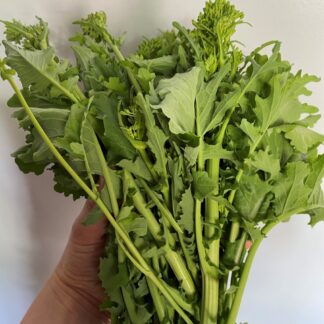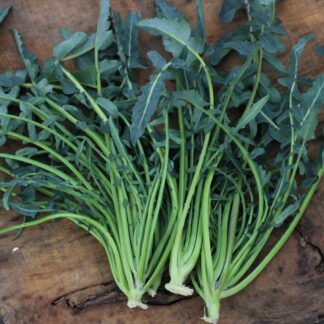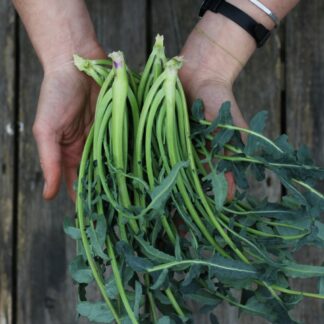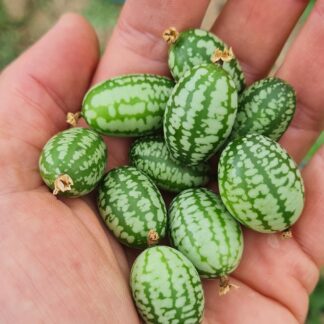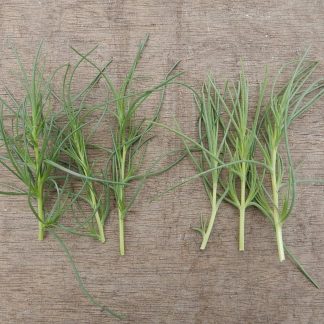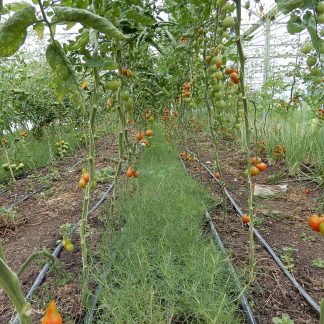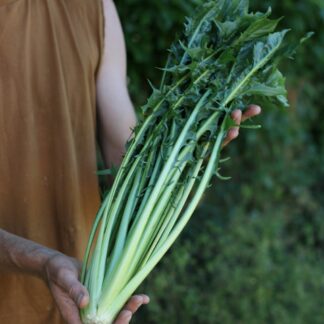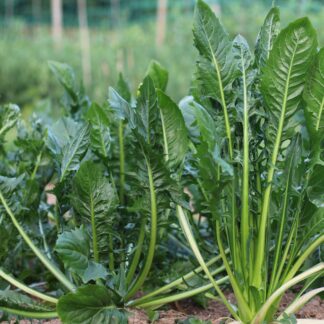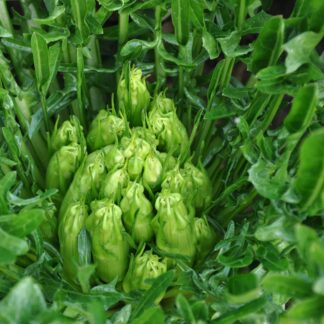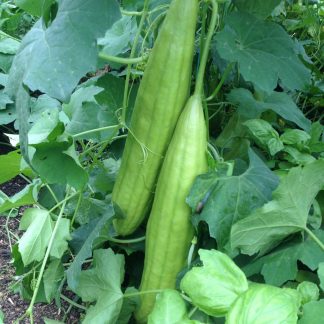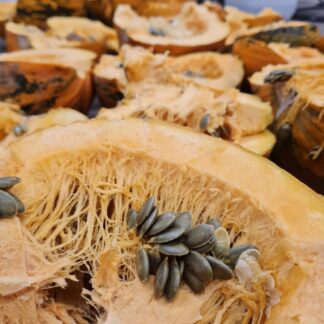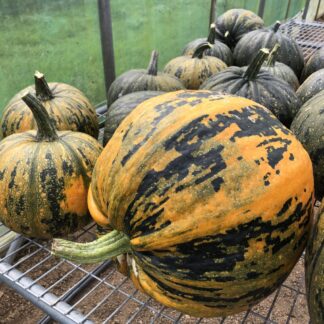Unusual vegetables
Growing calendar
Showing all 9 results
-


Cima di Rapa – San Marzano (Organic)
£2.10 – £3.00 Add to basket This product has multiple variants. The options may be chosen on the product pageCima di Rapa – San Marzano (Organic)
A really easy to grow broccoli alternative producing tender flowering shoots around 60 days from sowing. Cima Di Rapa (also known as broccoli raab), is actually botanically a type of turnip rather than a broccoli. As such it is very quick to grow and unfussy in terms of its water and nutrient requirements.
The flowering shoots are harvested like sprouting broccoli and if you take care not to remove the lower two leaves you can get a few cuts off them.
In Italy there are many different varieties of Cima Di Rapa, maturing at different times and with different culinary uses.
 £2.10 – £3.00
£2.10 – £3.00 -


Broccoli – Fiolaro di Creazzo (Organic)
£2.20 Read moreBroccoli – Fiolaro di Creazzo (Organic)
A traditional Italian type of broccoli sown in summer and harvested in autumn and winter. Broccoli Fiolaro di Creazzo has been cultivated for many centuries in Italy and is on the Slow Food Ark of Taste list which is a living catalogue of delicious and distinctive foods facing extinction.
It is sown in July through to early September and harvested November to March.
It does not grow a large central head, but produces side shoots – “fiois” – from its stem which are harvested and cooked with the leaves – not too dissimilar to Kalettes.
(Approximately 70 seeds / packet)
 £2.20
£2.20 -


Cucamelon (Organic)
£1.80 Add to basketCucamelon (Organic)
An unusual cucumber relative producing an abundance of grape-sized crunchy fruits. Cucamelons have become popular addition to the veg patch in recent years. Despite the name they are neither cucumber or melon but their own species, Melothria scarba.
They are best grown up a trellis system as they have a sprawling growth habit. Their fruits are crunchy, fresh and tangy, and make a great snack or pickle.
(Approximate seed count – 20) £1.80
£1.80 -


Agretti / Salsola – (Organic)
£2.05 – £4.00 Add to basket This product has multiple variants. The options may be chosen on the product pageAgretti / Salsola – (Organic)
A leafy Italian delicacy, can be eaten raw or cooked. Agretti is a popular Italian leaf which is slowly becoming more popular in the UK particularly with chefs. Its flavour could be described as ‘chivey samphire’ and is slightly salty. It can be lightly steamed, stirred through pasta, or added raw to salads to add an interesting twist. The seeds are only viable for a few months – they are actually little plants not strictly seeds.
 £2.05 – £4.00
£2.05 – £4.00 -


Chicory – Catalogna Gigante di Chioggia (SM4.32) (Organic)
£2.20 Add to basketChicory – Catalogna Gigante di Chioggia (SM4.32) (Organic)
Leaf chicory best used as a delicious sautéing green. Catalogna Gigante di Chioggia – also known as dandelion greens – is an open leaf chicory type which is similar to wild chicory.
The leaves make some of the best sautéing greens around, sweet with a slight bitter edge. They can be blanched in salty water to remove some of the bitterness if desired. Drain and fry up with garlic and chilli for a truly delicious side dish.
More forgiving to grow than some other chicory/radicchio types.
(Approximate seed count – 100) £2.20
£2.20 -


Chicory – Puntarelle (SM4.33) (Organic)
£2.50 Add to basketChicory – Puntarelle (SM4.33) (Organic)
An interesting chicory variety grown for its hollow bolting shoots. Unlike other chicory varieties which are grown for their leaves, Puntarelle is grown for its flowering shoots. The young shoots form a ‘head’ at the base of plant and are julienned into thin strips which are then soaked in cold water to removed some of their bitterness. In the water they twist and curl into elegant crisp and crunchy shapes which are then served with a punchy dressing to make a lovely late autumn salad.
Shoots usually appear between mid-October and November.
(Approximate seed count – 100) £2.50
£2.50 -


Luffa – Luffa aegyptiaca (Organic)
£2.65 Add to basketLuffa – Luffa aegyptiaca (Organic)
Annual climbing plant producing cucumber like fruits that can be made into a natural sponge. It’s part of the cucurbit family originating in India and produces 30 to 40 centimetres long fruits. Whilst the young fruits are actually edible, the mature ones can be boiled or dried to remove the flesh, revealing the sponge like fibres.
Germination can be tricky, needs hot temperatures constantly between 24 and 30°C and a long season to make a sponge.
The Luffas should be ready to harvest in October, once the skin of the fruits starts to wither. Harvest and stack them up somewhere warm, dry and airy, making sure to turn them. The skin should reach a point where it can easily peel off leaving the fibrous inner. Shake the seeds out and give a thorough wash to clean it. The luffa is likely to have natural brown markings on it; shop-bought luffas are bleached. (Approximate seed count – 15)
 £2.65
£2.65 -


Chicory – Radicchio Treviso Late (SM4.75 – Forcing) (Organic)
£2.50 Add to basketChicory – Radicchio Treviso Late (SM4.75 – Forcing) (Organic)
A forcing chicory from Treviso for delicious winter eating. This variety of chicory has been bred for forcing through the winter months (Tardivo means late in Italian), and produces totally delicious ‘chicons’
To force chicory the plants should be left untouched in the field until winter time. When you wish to force them, pull up however many plants you need and replant the roots into a moist medium such as sand or spent compost. The plants then need to kept in total darkness for a few weeks and then beautiful chicons will grow from the roots.
They are generally eaten cooked in pastas and other dishes and were the first Italian vegetable to gain IGP, a European protected status for special food products specific to a place of origin.
(Approximate seed count – 100) £2.50
£2.50 -


Hull-less Seeded Squash – Kakai (Organic)
£2.85 Add to basketHull-less Seeded Squash – Kakai (Organic)
Large round squash with mottled green stripes on orange-yellow and hull-less seeds for eating.
Certainly a striking variety renowned for its hull-less seeds, perfect for roasting and snacking. Native to Austria, each plant typically produces 2-3 squashes weighing 2-3 kilos, ideal for both seed harvesting and decorative purposes.
The seeds are rich in oils and packed with nutrients. Being shell-free seeds this makes them easy to prepare. They can be roasted for a savoury snack or eaten fresh, straight from the opened fruits. In the European cuisine this variety is commercially used to press and extract the nutrient-dense green pumpkin seed oil.
While primarily grown for its seeds, the flesh of the Kakai squash can be used, it has a mild flavour that complements soups, breads, muffins, or veggie dishes.
It thrives in full sun and well-draining soil, with semi-bush vines requiring enough space to spread.
(Approximate seed count – 10)
 £2.85
£2.85
Showing all 9 results

